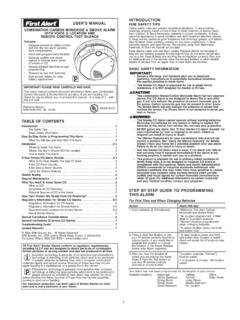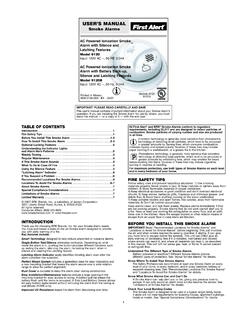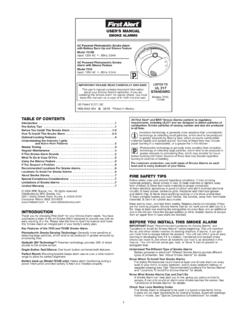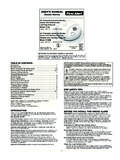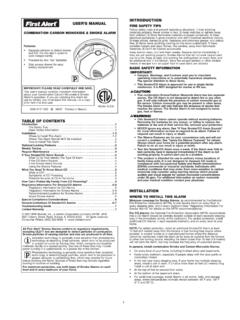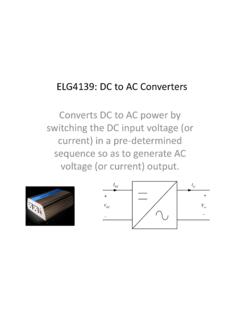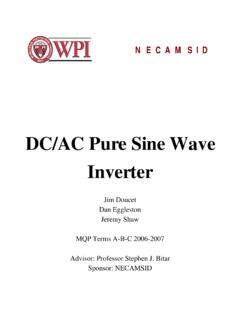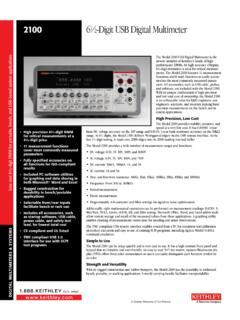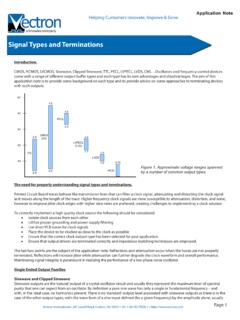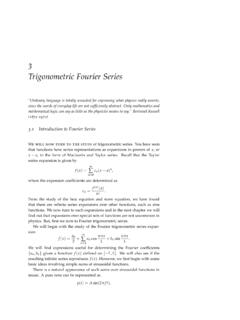Transcription of INTRODUCTION USER’S MANUAL BASIC SAFETY …
1 USER S MANUAL120V PLUG-IN CARBON MONOXIDE ALARM WITH SILENCE FEATUREM odelCO600 Printed in Mexico M08-0152-002 S07/07 IMPORTANT! PLEASE READ CAREFULLY AND user s MANUAL contains important information about your CarbonMonoxide (CO) Alarm s operation. If you ar e installing this CO Alarmfor use by others, you must leave this MANUAL or a copy of it withthe end ..1 BASIC SAFETY Information ..1 How Your CO Alarm Works ..1 Understanding Your CO Alarm ..2 Installation ..2-3 Where to Install CO Alarms ..2 Where CO Alarms Should NOT Be Installed ..2 How to Install Your CO Alarm ..3If Your CO Alarm Sounds ..3If the Alarm Signal Sounds ..3 Using the Silence Feature ..3 Testing and Maintenance.
2 3 Weekly Testing ..3 Regular Maintenance ..3 What You Need To Know About CO ..4 What is CO? ..4 Symptoms of CO Poisoning ..4 Finding the Source of CO After an Alarm ..4 Potential Sources Of CO In The Home ..4 How Can I Pr otect My Family? ..4 Regulatory Information for CO Alarms .. 5 General Limitations Of CO Alarms .. 5 Troubleshooting Guide .. 6 Limited Warranty .. 6 2007 BRK Brands, Inc., a Jarden Corporation company (NYSE: JAH)3901 Liberty Street Road, Aurora, IL 60504-8122 All rights Af fairs: (800) 323-9005 SAFETY INFORMATION Dangers, War nings, and Cautions alert you to important operating instructions or to potentially hazardous special attention to these items.
3 THIS IS NOT A SMOKE ALARM! This CO Alarm is designed todetect carbon monoxide fr om ANY source of combustion. It isNOT designed to detect smoke, fire, or any other gas. This CO Alarm is approved for use in single-family residences. This CO Alarm will only indicate the pr esence of carbon monoxide gas at the sensor. Carbon monoxide gas may bepresent in other ar eas. The Silence Feature is for your convenience only and will notcorrect a CO pr oblem. Always check your home for a potentialproblem after any alarm. Failure to do so can result in injury ordeath. This CO Alarm should receive continuous 120 VAC, 60 Hz, puresine wave electrical power. Do not use in an extension cord oroutlet controlled by a dimmer or switch.
4 NEVER ignore your Carbon Monoxide Alarm if it alarms. Referto If Your CO Alarm Sounds for more information. Failure todo so can result in injury or death. Test the CO Alarm once a week. If the CO Alarm ever fails totest correctly, have it replaced immediately! If the CO Alarm isnot working properly, it cannot alert you to a problem. This product is intended for use in ordinary indoor locations offamily living units. It is not designed to measure CO levels incompliance with Occupational SAFETY and Health Administration(OSHA) commercial or industrial standards. Individuals withmedical conditions that may make them more sensitive to carbon monoxide may consider using warning devices whichprovide audible and visual signals for carbon monoxide con-centrations under 30 ppm.
5 For additional information on carbonmonoxide and your medical condition contact your YOUR CO ALARM WORKSGENERAL INFORMATIONL eave your CO Alarm plugged in year-r ound. CO pr oblems canoccur any time during the year, and this Alarm can only alert you ifit is plugged in and receiving power. When fully powered, the unit samples the air and takes a new readingabout every second. A microchip inside the unit stores each reading, and remembers the levels of CO it has been exposed to over time. The Alarm sounds when it has been exposed to a critical level of CO(measured in parts per million or ppm ) within a specified time (meas-ur ed in minutes). This CO Alarm features a permanently installed sensor,an indicator light, and an 85 dB alarm horn.
6 It also has a SilenceFeature to temporarily quiet the alarm WARNINGThis unit performs daily self-diagnostic tests. If the Alarm malfunctions,it should be replaced COVER OF YOUR CO ALARM11 Test/Silence Button2 POWER/ALARM Light (Red)3 (Behind Cover) Alarm Horn: 85 dB audible alarm for test, alarm, and unit malfunction warning120V AC ~,60 Hz, UL 2034 INSTALLATIONWHERE TO INSTALL CO ALARMSThe National Fir e Pr otection Association (NFPA) recommends that a COAlarm should be centrally located outside of each separate sleepingar ea in the immediate vicinity of the bedrooms. For added pr otection,install additional CO Alarms in each separate bedroom, and on everylevel of your your bedroom hallway is longer than 40 feet (12 meters), install a COAlarm at BOTH ends of the a Single-level Home: Install at least one CO Alarm near or within each separate sleepingarea.
7 For added pr otection, install an additional CO Alarm at least 20 feet (6 meters) away fr om the furnace or fuel burning heat a Multi-level Home: Install at least one CO Alarm near or within each separate sleepingar ea. For added pr otection, install at least one CO Alarm on each level ofthe home. For added pr otection, install an additional CO Alarm at least 20 feet(6 meters) away fr om the furnace or fuel burning heat unit should receive continuous electrical power. Choose anoutlet where it cannot be accidentally unplugged or switched of f bychildren. Keep small children away fr om the unit. Teach them not toplay with it or unplug it. Explain what the alarms CO ALARMS SHOULD NOT BEINSTALLEDDO NOT LOCATE THIS CO ALARM: In garages, kitchens, furnace rooms, or in any extremely dusty,dirty or greasy areas.
8 Closer than 15 feet ( meters) fr om a furnace or other fuel burning heat source, or fuel burning appliances like a water heater. Within 5 feet ( meters) of any cooking appliance. In extremely humid ar eas. This Alarm should be at least 10 feet (3meters) from a bath or shower, sauna, humidifier, vaporizer, dish-washer, laundry room, utility room or other source of high humidity. In areas where temperature is colder than 40 F (4 C) or hotter than 100 F (38 C). These ar eas include non-airconditioned crawlspaces, unfinished attics, uninsulated or poorly insulated ceilings,porches, and garages. In turbulent air , like near ceiling fans, heat vents, air conditioners,fr esh air returns, or open windows.
9 Blowing air may pr event CO fr om reaching the sensors. In direct sunlight. In outlets covered by curtains or other obstruction. This CO Alarm is designed for use inside a single-family homeor apartment. It is not meant to be used in common lobbies,hallways, or basements of multi-family buildings unless work-ing CO Alarms ar e also installed in each family living unit. CO Alarms in common ar eas may not be heard fr om insideindividual family living units. This CO Alarm alone is not a suitable substitute for completedetection systems in places which house many people, likehotels or dormitories, unless a CO Alarm is also placed in eachunit. DO NOT use this CO Alarm in warehouses, industrial or com-mercial buildings, special-purpose non-residential buildings, orairplanes.
10 This CO Alarm is specifically designed for residentialuse, and may not provide adequate protection in YOU SEE AND HEAR DURING INSTALLATIONSUGGESTED AREAS FOR INSTALLING ADDITIONAL CO ALARMSBEDROOMBEDROOMHALLLIVING ROOMKITCHENBASEMENTBEDROOMREQUIRED TO MEET NFPA RECOMMENDATIONSWHEN YOU FIRST PLUG-IN THE CO ALARM:HORN:SilentPOWER/ALARM LIGHT: Shines continuouslyUNDER NORMAL CONDITIONS (AC POWER):HORN:SilentPOWER/ALARM LIGHT: Shines continuouslyWHEN YOU TEST THE CO ALARM:HORN:Sounds loudly - 4 beeps, pause, 4 beeps, pausePOWER/ALARM LIGHT: Flashes rapidlyWHAT YOU SEE AND HEAR UNDER DIFFERENT CONDITIONS:WHEN THE ELECTRICITY COMES BACK ON AFTER A POWER FAILURE:HORN:SilentPOWER/ALARM LIGHT: Shines THE CO ALARM IS NOT OPERATING PROPERLY (MALFUNCTIONSIGNAL):HORN:Three rapid chirps every minutePOWER/ALARM LIGHT: Flashes three times in sync with the YOU SEE AND HEAR IF CO IS DETECTED:ALARM LEVELS OF CO ARE DETECTED:HORN:Sounds loudly - 4 beeps, pause, 4 beeps, pause.
